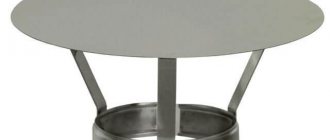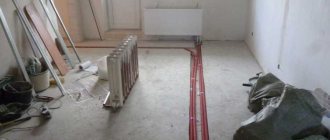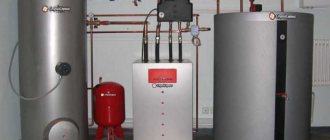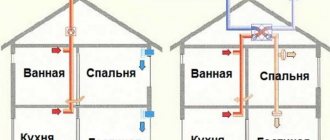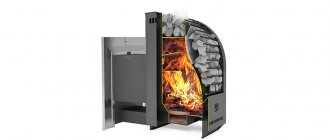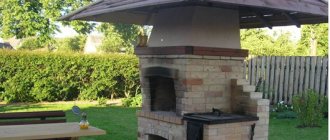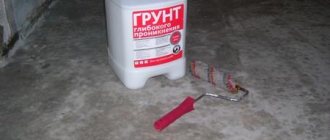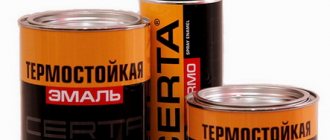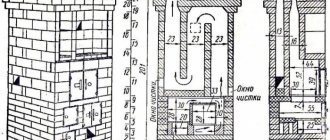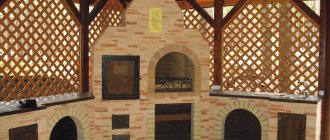It’s hard to imagine almost any country house without a barbecue. And a barbecue picnic is very popular in our country. Competent owners install awnings over their barbecues. And to eliminate smoke they make hoods.
There are only two varieties: mobile and stationary. The first is most often made of metal and can be easily transported. The second one needs to be constructed thoroughly.
When working with a barbecue will only take place indoors, smoke and fumes must be removed to ensure a comfortable environment in the resting place. Here you need a hood for the barbecue in the gazebo.
Specifics
The main aspect that should be taken into account is this: the hood dome is necessarily larger in area than the equipment over which it is located. This way the smoke is collected much more efficiently. The chimney should have a narrowing and bend. This improves the dynamics of exhaust combustion products and prevents reverse draft. The top side of the pipe is usually positioned at least 3 m from the ground. This provides the necessary exhaust conditions. If the cross-section of the chimney is incorrectly calculated, the result is ineffective removal of combustion results.
Every owner is especially proud when through his own efforts he creates both a barbecue and a hood for it
Thanks to additional components, the efficiency of the hood is improved. But this requires additional costs. These components are:
- Spark absorber The position is the top of the chimney. This is a tubular metal sieve. Smoke flows easily through it and sparks are extinguished.
- Grease catcher. This frame has a special cassette inserted (the cassette is replaceable) for capturing fat. When this device becomes dirty, it needs to be rinsed thoroughly or replaced altogether. It is important here how the model is set up and what filtering agent is used.
- Fan. It seriously develops traction power. When installing it, it is necessary to make competent calculations regarding the parameters of the required equipment.
Metal exhaust hood
The most universal option for most barbecues.
The hood is a metal umbrella that hangs over the fireplace area and draws in smoke and heat from combustion products. After the umbrella, the smoke rises through a metal pipe and through a metal chimney (we will look at it a little later) is released into the environment outside the gazebo.
Hanging from the wall
The price for such a “unit” starts from 3,500 rubles. It is made of thin galvanized steel (about 0.5 mm thick) to suit the individual dimensions of the fireplace. It can be used for a classic barbecue, barbecue, grill (the same umbrella is used in Finnish grill houses), tandoor and other cooking installations.
Making your own metal version
For a do-it-yourself barbecue, or rather its continuation, the arsenal of necessary tools and materials is as follows:
- Iron sheet. Thickness -3 mm.
- Metal corners. Parameters: 2 x 2 x 0.3 cm.
- Fastening components: rivets, screws.
- Heat-resistant enamel.
- Grinder with discs cutting metal.
- Welding equipment.
- Electrodes.
- Protective mask.
- Drill. Nozzles are used for drilling concrete.
- Riveter.
The umbrella is formed by a frame. Metal corners are used to create the frame. So the frame is finished with metal. The height of the umbrella reaches 2 m. Parameters of the barbecue on which the umbrella is placed: 105 x 60 cm.
An umbrella consists of three main components:
- Base. It is mounted on the grill.
- Dome.
- Internal jumper. It enhances the traction and pipe.
Stages of work:
1. Preliminary. The grill with the chimney is measured, or rather the future parameters. If there are differences in its size, then the design for the base changes.
2. Working with metal corners. The factory grease is removed from them. They are cut with a grinder (the parameters for each element of the grill are inserted into the drawing). Before using the grinder, do not forget to protect your eyes with special glasses.
3. Welding corners. From these, 2 side planes of the base of the hood are cooked.
4. Corners for the back side of the base of the grill are welded to these planes.
5. Assembling the lower side of the work umbrella canopy.
6. The corners of the rear plane of the dome are welded to this side.
7. Assembling the sides of the dome.
8. Pipe assembly.
9. After welding work, the exhaust seams are processed. A grinding device is used. To protect the metal from aggressive factors, the frame is coated with heat-resistant paint.
10. Markings are made on the iron sheet for finishing the umbrella.
11. The lines and fold edges are folded. The sheet is placed on the edge of the workbench and fixed there.
12. The base of the hood is covered with this sheet. Rivets and riveter are used.
13. Before finishing the dome, a metal plate is installed. It is placed diagonally inside. Its function is to develop traction. Such a plate can be an iron sheet with parameters 99x34 cm. Plus 2 cm at the edges for the edges. Using these edges, the plate is mounted on the underside of the dome.
14. Markings are made on the iron for finishing the dome. Then the sheet is cut.
15. The work umbrella pipe is trimmed.
16. The hood is covered with thermal paint.
17. The base is placed on the grill. They are fixed to the brick with appropriate screws.
18. The dome is installed. It is fixed to the edge of the base. Rivets are used.
19. The pipe is installed. It is strung on the dome. The fastening elements here are again rivets.
Often, steel and iron are used to make hoods in a garage or other non-residential stone building.
Brick
The principle of construction of a brick exhaust hood is the same as that of a metal one. The design also includes a smoke collector (nozzle), a pipe and an umbrella (visor).
However, such a structure has some features, if not observed, the entire structure will quickly fail. This may be dangerous for others. During operation, the grill tends to heat up to very high temperatures, in which case the destruction of ordinary silicate bricks will occur. Therefore, it is best to build such an umbrella from refractory or ceramic bricks.
To give the structure maximum strength, a special metal mesh is laid between the layers of brick. It is important that such a barbecue umbrella does not come into contact with a regular roof. When heated, slate will crack, paint will peel off from metal tiles, and soft roofing will deform under the influence of high temperatures. In this case, roll insulation will serve as a cushioning material between the chimney and the roof. It does not burn and takes any shape perfectly.
The disadvantage of this type of umbrella is that it will not be possible to move it after disassembling it into bricks. Also, cleaning the surface from carbon deposits is quite difficult, sometimes impossible.
Creating a brick version
To perform this work you need certain skills and knowledge. Brick hoods are usually created for stationary grills or barbecues, which are also made of brick.
How to do it right? Let's start with the stone. A suitable type of brick is fireclay, fire-resistant. The working composition is formed by clay and sand. The clay is soaked for two days. The maximum dose of sand in the composition is 30%.
Materials and tools
- to check the evenness of the masonry: rope, plumb line, level,
- for applying the composition: trowel,
- container in which the composition will be mixed.
For the base of the brick version, a frame is required. The masonry will be built on it. It is treated with fire-resistant paint. It is welded to the grill fittings.
Example of a brick barbecue and hood
Masonry
- The starting line is laid out in pushes, that is, with the shortest sides of the brick. Other lines are laid with long sides.
- If you are creating a standard hood, then 10 lines will be enough. And the masonry itself is carried out with a narrowing. On the front side the row can be shifted by 1.7 cm per level, on the end side - by 3.5 cm.
- Then follows the laying out of a square-shaped pipe: 5 lines of long sidewalls are needed. The upper side should reach a cross-section of 26 x 26 cm. With such parameters, the efficiency of the hood is enhanced.
- A valve must also be installed. A canopy is placed on top to protect the structure from precipitation.
- After masonry work, all masonry must dry thoroughly. This is a minimum of 24 hours.
- Then the entire masonry is coated with fire-resistant varnish in at least 2 layers. Better in three layers. This will significantly increase the service life of the equipment.
Spherical barbecue Forester
Advantages of a brick hood:
- Sturdy construction.
- Long service life.
Minuses:
- Problems with traction.
- Difficulty of manufacturing.
This type of masonry is the best option for an outdoor barbecue, since it does not imply limited space and there are dilemmas with traction.
Operating principle and purpose
The chimney above the barbecue is designed to perform two main functions.
- Removal of volatile combustion products and fumes from cooking food. An exhaust hood over such a brazier is a chimney, the action of which is based on creating the necessary draft in it, similar to barbecue stoves. This is due to the fact that when creating the necessary conditions for high-intensity combustion, the temperature of the heated smoke becomes such that it, being lighter than air, rushes upward. If there is an exhaust hood, this smoke is drawn into it without having time to dissipate, and is released from the pipe only at the end of the chimney. Such useful functions of the device relieve its owners from unpleasant volatile compounds.
- In addition to the fact that the main purpose of the umbrella is to remove smoke, its second function can be safely called the ability of this element to shelter from precipitation the place where the frying process takes place. The fact is that the smoke collector, being an expanding structure, covers the entire grill. As a rule, this role is played by a canopy or gazebo, under which the brazier is located, but the presence of an exhaust hood makes it possible to use it both under the roof and in an open area.
Features of choosing hoods for gazebos
- As a rule, barbecues are most often arranged in gazebos. Consequently, hoods for barbecues are also obtained there.
- The gazebo itself, its components and the grill must be made of fire-resistant materials. Wooden elements are impregnated with fire-resistant varnishes.
- Here you may have a dilemma: what kind of hood to install? If the grill is made of brick, then in most cases the hood is made of brick. It is characterized by an impressive operational period, but requires a lot of space for placement. That is, if your gazebo has large parameters and a brick grill, then the choice is given to a brick hood.
- If the gazebo is small and has a grill of modest parameters, then a metal hood will do.
These are the basics of choice. But they do not always have to be followed. It’s just that a metal version of a hood for a barbecue in a gazebo is easier and more efficient than a brick one. And it is she who is given preference most often.
What to look for when choosing a finished product?
Of course, you won’t always have the opportunity to do something with your own hands, so if you have the means, you can purchase a finished product. When you make your choice, be sure to pay attention to the volume of the internal chimney and the volume of the exhaust pipe. Also remember that the grill umbrella will be larger than the brazier itself: this is the only way it will be able to draw out all the combustion products and so on. If the metal exhaust hood is smaller, then it simply may not cope with the entire scope of work.
Other variations
Nobody limits your creativity when working on a hood. Of course, you need to follow certain rules.
But you can make a brick base, this is a base for a barbecue with a pipe. The pipe can also be built with bricks, or it can be made of metal.
Examples:
Also, no one obliges you to follow the classic shape in the form of the letter P. You can build a corner structure.
You can use wild stone to decorate a brick structure
Wood can also be used for decoration. It is better for them to upholster the metal version. Gaskets are needed here to insulate heat
General characteristics
A barbecue hood, like any other ventilation system, is designed to purify the air, and in this case also to remove combustion products, food odors, etc. Its design solutions can be varied, based on the required power, location of the barbecue, etc.
However, the principle of operation of the hood itself is quite simple - it does not contain complex components and mechanisms. In its most general form, it can have two design solutions:
- Exhaust umbrella for barbecue.
- Ordinary chimney.
If everything is more or less clear with an ordinary chimney, then few know what is meant by an exhaust hood. This device is designed to remove smoke, fumes, grease and soot that arise during the use of the barbecue. Such umbrellas can be designed in different shapes - dome, parallelepiped, truncated pyramid.
The hood can be made of metal or brick; it can be stationary or portable.
There are no difficulties in acquiring an exhaust system or even making one for the barbecue with your own hands. However, it is worth considering a number of nuances, the main one of which is the location.
Features of organizing hood indoors
- As a rule, metal structures are made in the premises. Barbecues placed indoors must burn coal and solid fuel and be closed. Setting up an open grill is dangerous and illegal.
- The organization of the hood must not violate SNiP 41-01-203, clause 6.2.5. – 6.27.
- It is necessary to install a hood and arrange a separate vertical air duct. Its head should be 2 m below the roof ridge.
- The air duct must be equipped with hatches to make it convenient to clean it from soot.
- The hood is placed above the grill. Add-ons are installed: a labyrinth spark arrester and a grease trap. The fan is placed on the roof.
- If it is not possible to arrange a vertical outlet, you can install a hydrofilter after the hood. After it, install a check valve and powerful air purification technology.
